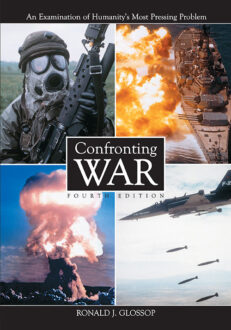Confronting War
An Examination of Humanity’s Most Pressing Problem, 4th ed.
$39.95
In stock
About the Book
This immensely successful textbook is broken into four parts. Part One: Introduction to the War Problem discusses the nature of the war problem, the conceptual framework, and the historical framework. Part Two: Causes of War talks about the cause of war, group competition and group identification, other views about causes of war, and the value of war. In Part Three: The Contemporary Situation, the reader will learn about ideological aspects, national-historical aspects, military aspects, institutional aspects, and legal aspects of the contemporary situation. Part Four: Proposals for Solving the War Problem discusses reforming the attitudes of individuals, reforming the internal operation of national governments, reforming the policies of national governments, and reforming the international system. It also includes maps, tables and charts which will be especially helpful to the reader. Instructors considering this book for use in a course may request an examination copy here.
About the Author(s)
Bibliographic Details
Ronald J. Glossop
Format: softcover (7 x 10)
Pages: 334
Bibliographic Info: maps, tables, notes, bibliography, index
Copyright Date: 2001
pISBN: 978-0-7864-1121-4
eISBN: 978-0-7864-5030-5
Imprint: McFarland
Table of Contents
List of Illustrations, Maps, and Charts x
Preface 1
Part One. INTRODUCTION TO THE WAR PROBLEM
1. The Nature of the War Problem 3
The Importance of the War Problem 4
The Four Aspects of the War Problem 5
2. The Conceptual Framework 10
The Meaning of the Term “War” 10
An Alternative to War? 15
The Meaning of the Term “Peace” 18
The Meaning of the Term “Justice” 20
The “Just War” Concept 23
Further Reflections on Peace and Justice 26
3. The Historical Framework 30
The History of Warfare Between Sovereign States 30
Wars Since 1946 35
The Changing Nature of War 47
The Present Urgency of the War Problem 53
PART TWO: CAUSES OF WAR
4. The Cause of War: General Considerations 57
Investigating the Cause of War 57
Individual Human Aggression 60
Individual Aggression and War 65
5. Group Competition and Group Identification 68
Arenas of Group Competition 68
Group Identification and Nationalism 75
Nationalism as a Cause of War 79
6. Other Views About Causes of War 84
Arms Races as a Cause of War 84
Military Planning as a Cause of War 86
Particular Villains as a Cause of War 87
War as an Effort to Suppress Internal Dissension 93
War as an Effort to Eliminate Injustice 94
The Absence of Peaceful Alternatives as a Cause of War 95
7. The Value of War 97
The Biological Value of War 97
The Technological Value of War 98
The Economic Value of War 99
The Psychological Value of War 101
The Social Value of War 102
The Moral Value of War 103
Will War Be Missed? 104
PART THREE: THE CONTEMPORARY SITUATION
8. Ideological Aspects of the Contemporary Situation 106
Some Basic Distinctions 106
Capitalistic Democracy 112
Communism (Marx, Lenin, and Mao) 117
Fascism (National Socialism) 123
The “End of History” Thesis 125
Religion and War 126
9. National-Historical Aspects of the Contemporary Situation 129
The U.S. Perspective 129
The Russian Perspective 136
The Western European Perspective 144
The Japanese Perspective 147
The Chinese Perspective 150
The Less Developed Countries 155
10. Military Aspects of the Contemporary Situation 159
The Post-World War II Struggle for Power 159
Deterrence Theory 160
The Cuban Missile Crisis 161
Modern Nuclear Weaponry 162
Missile Defense Systems 165
Modern Non-Nuclear Weaponry 168
Weapons and War 170
11. Institutional Aspects of the Contemporary Situation 171
The Structure of the United Nations 171
U.N. Peacekeeping and Nation-Building 174
Dominant Influences in the United Nations 182
Accomplishments of the United Nations 186
Worldwide Functional Agencies 190
Regional Functional and Political Organizations 192
International Nongovernmental Organizations 195
12. Legal Aspects of the Contemporary Situation 198
The Nature of International Law 198
The Evolution of International Law 200
Laws of War 203
The Sources of International Law 204
Enforcing International Law 205
PART FOUR: PROPOSALS FOR SOLVING THE WAR PROBLEM
13. Reforming the Attitudes of Individuals 209
Interest in Social Issues Including International Affairs 210
Skepticism and Tolerance 211
Taking Personal Responsibility 212
Reluctance to Use Violence 212
Unselfishness 213
Globalism and Humatriotism 214
World Citizenship 217
Looking Forward Rather Than Back 218
Overcoming Defeatism and Apathy 218
14. Reforming the Internal Operation of National Governments 220
The Western Approach 220
The Marxist Approach 223
The Gandhi-King Approach 226
15. Reforming the Policies of National Governments 229
Peace Through Military Strength 229
Peace Through Alliances 232
Peace Through Neutrality and Economic Self-Sufficiency 234
Peace Through Strictly Defensive Strength 235
Peace Through Civilian Defense 237
Peace Through Arms Control 239
Peace Through Renunciation of War 241
Peace Through Conciliatory Moves and Confidence-Building Measures 242
Peace Through Good Relations, Morality, and Cooperation 244
Peace Through Third-Party Involvement 248
Peace Through International Conflict Management 251
Peace Through Peace Research and Peace Education 254
16. Reforming the International System 257
Limiting National Sovereignty in Specific Situations 259
Consolidating Nations into Larger Units 265
World Government Through Federation 269
World Government Through Functionalism 275
World Government Through Direct Citizen Action 279
A Note to the Reader 285
Chapter Notes 287
Selected Bibliography 309
Index 313
Book Reviews & Awards
- “comprehensive…one must admire the scrupulous treatment”—Choice
- “well-written”—International Journal on World Peace
- “sound educational tool”—International Peace Studies Newsletter
- “a thorough and painstaking study”—The Human Economy Newsletter
- “useful…very readable…well written…a treasure house”—Peace Research
- “worth reading…a masterful analysis of the war problem”—World Federalist
- “recommended”—Transnational Perspectives
- “excellent”—Science Books & Films






